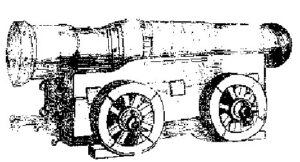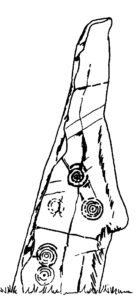David Kaiser goes in quest of the ‘original’ Long Meg.
Long Meg and Her Daughters is one of northern England’s most famous prehistoric monuments. It’s an impressive site. About five miles N of Penrith, it is Britain’s sixth largest stone circle. It originally consisted of a ring of about seventy large stones standing in an oval on sloping ground. Fifty-nine stones, known as Her Daughters, still remain (however, like many other stone circles, the stones are said to be uncountable). Outside the circle to the SW stands the twelve-foot high sandstone pillar known as Long Meg.
Unlike the rest of the stones, Long Meg is not a local girl but is thought to have come from the Eden valley a mile and a half away. Although probably older than the circle itself, when viewed from the centre Long Meg is precisely aligned with the midwinter sunset. This may account for the spiral prehistoric carvings on the stone’s SE side. If ever broken, the outlying stone is also said to bleed.
But who was Long Meg? How did the stone get its name?
Popular tradition says that Long Meg and her Daughters were a coven of witches. They were turned to stone by the Scottish wizard Michael Scot who caught them holding their sabbat. Variations on this story exist, such as the stones being turned to stone for dancing on Sunday or that they are Meg’s lovers. Such petrifaction legends are not uncommon. Similar stories are told about Stanton Drew, the Merry Maidens and others. However, these common variations don’t seem to further the quest for origin of Meg’s name. So, what about the details in our original story? Unusually, the participants are given names beyond the generic witch or Devil.
Let’s start with Michael Scot, as he was a known historical person. A man of great learning in the 13th century, Scot worked as a physician and astrologer at the imperial court of the Holy Roman Emperor Frederick II. Proficient in Arabic, among other languages, he was credited with introducing the works of Arab scholars to the West. Although he condemned magic in his own writings, his reputation as an astrologer and knowledge of mathematics led to him commonly being thought of as a wizard.
After Scot’s death all sorts of feats were ascribed to him. He was said to have flown to Rome on his magical horse and, like the giants before him, he was credited with great feats of engineering. He cleft the Eildon hills, redirected rivers, and with the help of the Devil he was said to have built Hadrian’s Wall and Watling Street.
At some point his legend became attached to several places in Cumbria. A late tradition credits Scot with building Bolton Old Church in one night with the help of demons. In addition, the Cistercian Abbey of Holm Cultram and the church in Burgh under Bowness are a couple of the places south of the boarder in which he is said to be buried. It isn’t clear exactly when he became associated with Long Meg and her Daughters, but he does not feature in the oldest recorded versions. He may well be a later introduction like that at Bolton Old Church. Although he was said to consort with demons, I haven’t found any traditions linking him to witches. He, therefore, sheds little light on the identity of Long Meg.
Camden was the earliest to mention the stones by name, taken from a description sent to him by the antiquary Reginald Bainbrigg about 1600. Some minor variations has been recorded over the years, such as ‘Stony Meg’ (1634), and ‘Great Mag and her Sisters’ (1698), but they are clearly variations of the same. So who is Long Meg?
One possibility is Meg Mullach, meaning Hairy Meg, who was first mentioned by Aubrey in his Miscellanies. She was a Scottish brownie covered in hair who, along with a male brownie companion, haunted the castle of Tullochgorm. Their reputation and territory later spread. She was said by some to come down the chimney and carry away babies. Even as late as the 20th century tales of Meg and her companion were being recorded.
That Meg Mullach is Long Meg is unlikely. It is a roughly contemporaneous tale to early records of Long Meg, and similar fairy beliefs exist in Cumbria, but stories of Meg and her partner seem only be associated with the Scottish Highlands. Furthermore, the traditions associated with Long Meg do not seem to hint that she was a brownie. Meg Mullach, rather than being associated with her daughters, or other women, is usually linked to a lone male companion.
Some have identified Long Meg with Meg of Meldon, an early 17th century witch from Northumberland. Her ghost is still said to haunt the bridge in Meldon and the site of Newminster Abbey. Meg of Meldon was a witch, like Long Meg in our story, and is roughly close in time and location. This is a closer match; however, she hasn’t traditionally been associated with sites in Cumbria either. In addition, if we are looking for corroborating evidence, she lived several centuries after Michael Scot (even though mythic time in notoriously flexible). Perhaps the most damning evidence is simply that of the dates. The name Long Meg was already applied to the stones about 1600. This was prior to, or at best contemporary with, the real Meg of Meldon, too early for her name to be applied to the monument.
Long Meg is sometimes also referred to as a giant. This is interesting for a couple of local reasons. Cumbria has many legends concerning the graves of giants, the most famous being the one in nearby Penrith churchyard (marked by a collection of hogbacks and broken crosses). John Aubrey, in the 17th century, wrote that two cairns stood within the Daughters stone ring. Inside of these were found ‘a Giants bone, and Body.’ The facts, or otherwise, surrounding these giant bones is impossible to prove, but in 1725 Stukeley could make out traces of these cairns. Nothing of these features is now visible.
Without venturing too far down the etymological slippery slope, Alby Stone1 recently pointed out a possible link between the name of the giant Gogmagog and the Celtic mag-, meaning ‘great, mighty.’ The words sound quite similar and as we saw above, Long Meg was sometimes also referred to as Mag . So perhaps there is some link between the stones and Celtic giant lore, but this is just speculation.
That brings us to Long Meg of Westminster. She too was a giant. Her name was widely known in the 17th century, but tales of her adventures go back a hundred years prior to that. The Life and Pranks of Long Meg of Westminster was published in 1582 and other pamphlets as well as plays followed in the 1590s. Contemporary allusion to Long Meg were also abundant.
Long, meaning tall, Meg was originally a Lancashire girl. She disguised herself as man and sought adventure. Later she joined Henry VIII in his fight against France in the mid-16th century. She wedded a soldier and eventually set up a pub in Islington.
It is said that she is buried on the S side of the cloisters at Westminster Abbey. Here there is a large blue-black marble slab marking her grave. However, there are those who doubt that a woman would be buried in a monk’s graveyard and say that it marks a mass grave of monks who died of the plague.
How then, could this adventuress become associated with a stone circle in Cumbria? The widespread fame of Long Meg is evidenced by the proverbial use of her name from the late 16th century onward. Thomas Fuller, in his Histories of the Worthies of Britain (1662), said that it ‘applyed to persons very tall especially if they have hop-pole heighth wanting breadth proportionable thereunto.’ Not only applying to women, we read in Edinburgh Antiquarian Magazine (1769) of a six-foot six-inch tall man who was commonly called Long Meg of Westminster. The term ‘Long Meg’ or simply ‘Meg’ also became applied to anything that was long and thin. In addition, it usually connoted something that was of large size. This was perhaps also due to the similarity of the Greek megas meaning great, commonly used in the mega- prefix denoting size, similar to the Celtic mag- previously mentioned.
The huge cannon at Edinburgh castle was known as Roaring Meg from at least 1575. Later other terms were also applied such as Muckle Meg, Great Meg and Mons Meg (having been cast at Mons in Flanders). The Meg appellation, however remained constant. The connection between Roaring Meg and Long Meg of Westminster is further strengthened by the heroine featuring in Tyro’s 1598 play entitled Roaring Meg.
So from an early date the popular tales of Long Meg were known and the name used as far north as Edinburgh. This is prior to any records of the name being applied to the monolith outside the Cumbrian stone circle. It is therefore not unlikely that the proverbial term for a tall, slender and large object was known at this time and applied to the stone. This either attached itself to the petrifaction legend, predated it, or helped instigate it. Later, probably by means of comparison, the nearby smaller stone circle of Little Meg was also named.
Debate continues as to who the real or original Long Meg of Westminster may have been, or whether she was entirely fictional. For our case, however, this is moot. It was clearly the proverbial popular character who lent her name to the stone circle, far north of Westminster.
 Edinburgh’s cannon, Long Meg
Edinburgh’s cannon, Long Meg
Notes
Stone, Alby, ‘Gog and Magog in the English Tradition‘, 3rd Stone 42, 2002, p.17.
See also Eric Ratcliffe, Ratcliffe’s Megathesaurus: a terminological miscellany, 1995. Hilltop Press, 4 Nowell Place, Almondbury, Huddersfield HD5 8PB. £2.50 + p&p
Published in NE90, Summer 2002, p22-24
